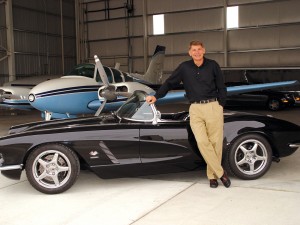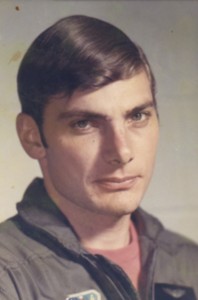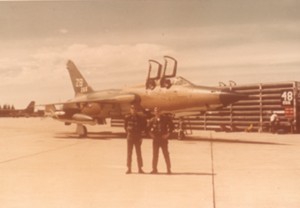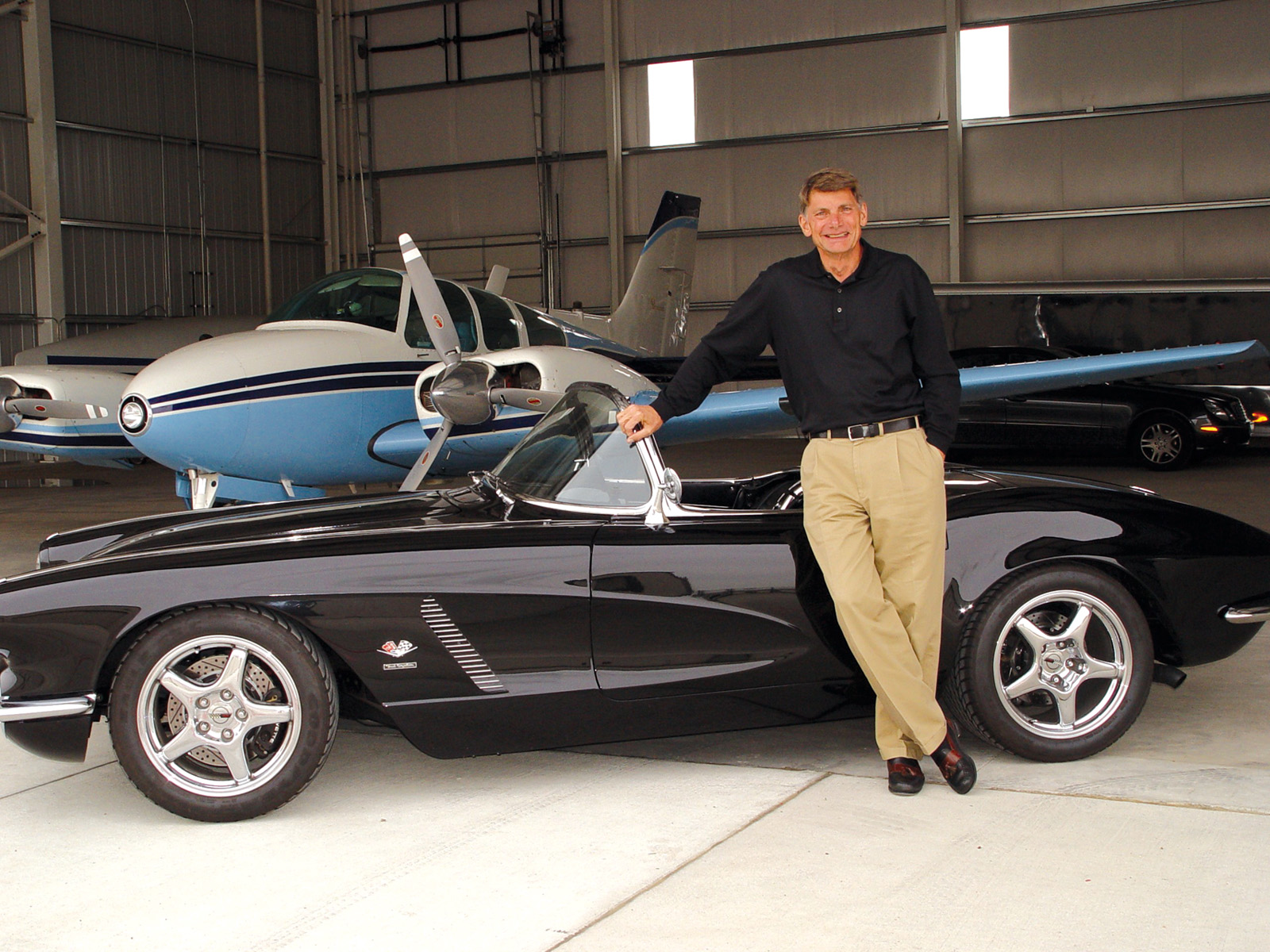By Di Freeze

Charlie Johnson, in front of his 1962 Corvette LT4 Grand Sport, occupies a hangar at Centennial Airport with Paul Besterveld.
Stallion 51 proprietor Lee Lauderback describes Charlie Johnson, a new tenant at Centennial Airport, as pure “fighter pilot.”
“The fighter pilot mold is a special mold,” he said. “Those characteristics never go away. Charlie is fighter pilot from one end to the other. He’s also one of the most professional and skilled aviators I’ve ever had the privilege of flying with.”
Johnson, said Lauderback, was his mentor and instructor for a particular period, when he was working on being typed in a Learjet. At the time, Johnson was Arnold Palmer’s chief pilot, and Lauderback was working for Palmer part time.
Lauderback grins sheepishly and says that although it wasn’t the norm, he remembers a few days in the Lear 24 when Johnson was “brutally tough” on him.
“I was like, ‘Holy Mackerel!'” he said. “I remember getting off the Learjet one day and going around the hangar and crying. He was a very talented instructor, and a very talented pilot. Good wasn’t good enough, though. It was, ‘You do this until you’re really good; if you can’t be the best at what you’re going to do, find something else to do.’ That day, I remember thinking, ‘I’ll pull my bootstraps up and I’ll get this right!’ I really thank Charlie for bringing me to a higher standard early on in my aviation career.”
Johnson, surprised about his friend’s “confession,” said Lauderback turned out to be an “outstanding pilot.”
“He responded well to everything,” he said. “He had the potential.”
Johnson says other people have made similar comments, which, again, surprise him, since he’s always considered himself “easy going.”
“I know in the fighter squadron I was always very aggressive and very combative, but I always got along with everybody. At least I thought I did!” he laughs.
He adds that he hopes he’s set a high standard in every business venture he’s entered.
“But I always think you could do that without beating people up,” he said.
Lauderback says he knows Johnson has never deviated from his own standard.
“I don’t care if it’s flying the Learjet, cars, or as the president of Cessna Aircraft Corporation,” he said.
Johnson’s interest in aviation goes back to his youth and Uncle Charles Johnson.
“He was a B-24 pilot and came back from World War II as an instructor,” he said. “He took me for a ride in a Piper J3 Cub and did a loop and some spins. I was three years old; I got off the airplane laughing. That’s all I ever wanted to do all my life.”
Born in Georgia, Johnson was “raised in Memphis, graduated high school in Chicago, went to college in Iowa, and then spent 11 years in the Air Force.”
While in Memphis, he would work at FBOs to get flying time. Later, with two years of college under his belt, he went to an Air Force recruiter, intent on becoming an aviation cadet.
“I enlisted in the Air Force, planning on going to cadet pilot training,” he said. “Right after I enlisted, they cancelled the pilot training part of aviation cadets. Instead, I went to aviation cadet’s navigator training first. After I graduated from that, I served as a navigator for a couple of years and then went back to pilot training.”
Johnson ended up in Colorado, stationed at Lowry, in 1961.
“My barracks is still there, ironically,” he said. “That’s the only one they haven’t torn down.”
He was at Lowry for a year, and then went to Barksdale AFB, La., where he worked on B-52s. In 1963, he went to aviation cadets at Waco, Texas. In 1964, he was commissioned and went to Mather AFB, Sacramento, Calif., for a year of training. Following that, he went to Wright-Patterson AFB as a B-52 navigator, and then to pilot training at Moody Air Force Base, in Georgia, in 1968.
“It was a long road; from the time I enlisted until I had my wings, it was seven years,” he said.
For the next four years, he flew F-105 fighters, which he said was the “most fun job in the world.” During those years, he went from McConnell AFB, Wichita, Kansas, to Kadena Air Base in Okinawa, back to McConnell and then to Korat Air Base in Thailand, flying F-105 Wild Weasels.”
He was there for about 11 months, and flew over 100 missions, accumulating over 1,000 hours of military flight time in the F-105, serving in combat in Southeast Asia, mainly over North Vietnam.
Once out of the military, Johnson planned on being an airline pilot, but when the airlines weren’t hiring, he went to work for Figi’s, a cheese and gourmet foods company in Wisconsin, flying a Beech 18. About seven months later, in 1972, he became Arnold Palmer’s chief pilot, after his father pointed a help wanted ad out to him in the Wall Street Journal. (See “Arnold Palmer and his Chief Pilots—A Close-knit “Fraternity,” on page 4-B.)
He worked for Palmer for three years, flying a Lear 24, until Gates Learjet recruited him.
“I tried to get on with Learjet while I was stationed at McConnell, but I didn’t have any Learjet time,” he said. “They approached me while I was working for Arnie and wanted to know if I still wanted to go in flight test with them, now that I had a thousand hours Learjet time.”
At Gates Learjet, Johnson started as a test pilot in production flight test.
“When we opened up Tucson, I became chief of production flight test in Wichita,” he said.
While he was there, they built models 24, 25, 28, 29, 35 and 36.
“They were just starting the 55 when I left,” Johnson said.
He worked for Lear for three years. Then, through Palmer, he met Russ Meyer, Cessna’s chairman and CEO.
“I answered the phone one night when I was at home, said ‘Hello,’ and heard this knocking sound,” he recalled. “I said ‘Hello’ again, and nobody was there. I heard this knocking again. I said, ‘I’m sorry. I’m going to have to hang up. I have a bad connection.” This voice said, ‘Charlie, don’t hang up! You know what that is? It’s opportunity knocking.’
The voice belonged to Meyer.
“He said they had an opening in flight test over at Cessna,” Johnson remembered. “They had production flight test under engineering. He wanted to take it out from under engineering.”
Johnson began working for Cessna in 1979.
“Not that Learjet is not a very big pond, but Russ always said, ‘Would you rather be a big fish in a little pond or a big fish in a big pond?'” he said.

After enlisting in the Air Force with the hope of going to cadet pilot training, Charlie Johnson went to aviation cadet’s navigator training. After graduating, he served as a navigator for a couple of years before pilot training.
Johnson started as manager of production flight test, and was responsible additionally for the majority of the quality responsibilities at Cessna by the mid-eighties, when Koch Industries, a large privately held company in Wichita looking for an exceptional Learjet pilot, recruited him. A significant increase in salary was a great incentive for the family man, and he took the job managing their flight operations.
“It was a very interesting experience,” he said. “Going to work for that company was like an accelerated master’s degree. They were great people to work for. The job really helped me with my business education.”
About four years after he left Cessna, in 1988, Johnson received another call from Meyer, asking him to lunch. Meyer told him that the vice president of aircraft completion and product support had retired.
“He said, ‘I just wanted to check and see if you knew anybody that could handle that job,'” Johnson recalled. “I said, ‘Russ, I don’t know ‘anybody’ who could handle that job.’ He said, ‘We were talking about you.'”
Johnson accepted that position.
“Basically, I had the responsibility for all the manufacturing side of the airplane, out the door—paint, interior, flight test—and then all the worldwide product support, service facilities, parts and distribution,” he said.
That later became a senior vice president position. Following that, he became vice president of operations and then senior vice president of operations, in 1993, executive vice president of operations, in 1995, and president and chief operating officer, in 1997. At that point, he was responsible for the entire company from an operations standpoint.
“From 1997 until I retired, I was president,” he said. “From 1997 until 2002, I was chief operating officer. Then, until I retired, I was responsible for the whole company.”
In official press releases, although he retained his current title of president, Johnson “took the helm” at Cessna, as its top executive in March 2003, with Meyer’s retirement as CEO. Meyer retained the title of chairman, remaining involved in strategic business matters. Johnson took over full responsibility for the Textron unit, the world’s leading producer of light and mid-size business jets.
“I basically had the responsibilities of the CEO but without the CEO title,” he said.
Both Johnson and Meyer reported directly to Steve Loranger, Textron executive vice president and COO.
By that time, Johnson held airline transport and instructor pilot certificates with type ratings in all Cessna Citation models, and had logged over 14,000 hours of commercial flight time. But his reign at the top of Cessna would be cut short, due to a quirk of fate.
In late June of 2003, Johnson’s children demanded he see a doctor, due to a bad head cold he couldn’t shake. Although he doesn’t “go to doctors,” except for his faithful annual checkups, his children’s wish prevailed, and he went and was given an extremely powerful antibiotic and told to take it for seven days. He did, even though his head cold went away in about one.
“I basically had never missed a day of work in my life or been sick,” he said. “Two weeks after that, my whole intestinal system just went crazy. The antibiotics completely upset the balance; it killed all the good bacteria and the bad guys took over. Something had been dormant; it could have gone all the way back to Thailand. It took four or five months to even figure out that much. I thought I had every disease in the world.”
Although it was anything but funny at the time, Johnson now says it was a “comedy of errors.” After taking his first dose of antibiotics, he found himself very ill and losing weight. Another trip to a different doctor resulted in another prescription for antibiotics and worse problems, followed by still another prescription for antibiotics. Test after test followed.
“It took me a year to get back to normal again; I still don’t know what finally fixed it,” he said. “I started exercising—which I abhor—watching what I was eating—which I abhor—and stopped drinking—which I really didn’t like. For the record, I’m extremely healthy now. I’m as healthy as I’ve been in the last 10 years right now. More energy, all that good stuff.” He grins and adds that he’s happy he can again drink beer.
In the meantime, Cessna needed a leader, and Johnson’s serious health problems hadn’t yet vanished. In August 2003, he announced he was taking a medical leave of absence, and temporarily turned over the reigns to Jack L. Pelton, Cessna’s 45-year-old senior vice president of product engineering. Four months later, when he still hadn’t shaken his health problems, in December 2003, Textron announced that Pelton had been named president and CEO of Cessna, assuming full leadership responsibilities for the business, following Johnson’s retirement.
“Jack had done a super job,” he said. “Textron had kind of developed a trust.”
Johnson compares his sudden departure from Cessna to “an unfinished symphony.”
“Nothing I can do about it, so I’m just going to keep charging,” he chuckles.
A new beginning
He explains that his move to Colorado, after leaving Cessna, was a natural decision.
“A lot of people thought we were kind of abrupt in our move,” he says frankly. “I had such deep roots in Wichita and I was very active in the state and in the community.”
That included being a member of the Kansas Business Roundtable and Wichita Metro YMCA Board of Directors, as well as president of the Kansas Technical Training Initiative Board of Directors.
“Plus, we lived on an 80-acre farm that I loved,” he said. “We just decided we probably should make a clean break.”
He and wife of 38 years, Gayle, who lived in Andover, Kansas, were already looking for a second home in Colorado.
“I’ve always loved Colorado. We were just going to spend time out here,” he said. “My son-in-law, Shawn, who is a United Airbus instructor at the training center here, and daughter Michelle, 36, live at Lowry (now a developing mixed-use neighborhood) with my two grandsons. I love the climate and the great people. So, when all this occurred, we just made a clean break.”

From 1968 to 1972, Charlie Johnson went from McConnell AFB to Kadena Air Base in Okinawa, back to McConnell and then to Korat Air Base in Thailand, where he flew the F-105 “Wild Weasel.”
The Johnsons bought their home near Golden, Colo., in April 2004.
“The moving vans moved everything out here in June. We had the final option on our farm in August,” he said.
Johnson, 61, jokes that he’s “self-unemployed right now.”
“It’s about five years earlier than I planned on retiring,” he said. “I just plan on having fun.”
He hints at going into business with a partner, doing something that will give Lee Lauderback a little extra business (hint: it has to do with P-51s).
“I get into the dark shadows when I say this, but there are other things that Lee and I are talking about,” he says mysteriously.
In the meantime, he’s been keeping busy. For one, he now lives near the “greatest kids on the face of the earth.”
“When Jackie, my youngest grandson (who is now 3), was born, I bought him a lifetime membership to Wings Over The Rockies,” he says proudly. “To my knowledge, he’ll probably be the only museum member that has a lifetime membership through ‘his’ entire lifetime. He loves to go there. He loves machinery.”
He adds that they were fooled, because they thought Charlie, his eldest grandson, who is 5, was going to be the aviator instead.
“He’s going to be a naturalist and a college professor,” he said. “He’s a really smart kid.”
Both grandsons were initiated into aviation at an early age.
“From the time they were two weeks old, I’ve been taking them in airplanes and logging flight time,” he said. “Both of them have logbooks. I have pictures of them at that age sitting in the cockpit holding the controls.”
The flying gene didn’t skip a generation either. His daughter, Christine, 32, has her private pilot’s license. She earned her degree in creative writing and now works for Jet Propulsion Laboratory in Pasadena, Calif.; she’s a member of the Mars Odyssey team, and handles video production and public relations for the NASA program.
Although Johnson doesn’t have a plane at the moment, he says it’s just a matter of time, and he’s determining what it will be. An obvious choice would be a Cessna model, since he’s flown “everything” they have.
Until then, he does have a “very minor” interest in a T-28 in Wichita, with Russ Meyer.
“It’s primarily his aircraft,” he said. “I’m just sort of the caretaker and fly it occasionally.”
Cars and more cars—and motorcycles
According to Johnson, life is all about “doing things that are fun.” In his case, that also includes cars—and motorcycles.
He says as far as he’s concerned there’s only one kind—Harley-Davidson. He has three at the present time. One thing Johnson misses since leaving his farm in Wichita is his storage garage. His love of cars, he said, is third only to his family and airplanes.
“Since the move to Colorado, I have them scattered all over,” he said.
Even before moving here, he had already made “car” friends, including Harry Mathews. The Mathews Collection is one of the finest collections in the country and the largest McLaren collection in the world. Jerry Lips, Airport Journals publisher, was recently introduced to Johnson, through Mathews, their mutual friend.
Although he loves cars—the faster the better—Johnson says he’s never raced, and grins when he adds why.
“When you go Mach 2 in an F-105, that’s racing,” he said. “Yanking and banking, flying fast and shooting the gun.”
Anything after that it is a little anticlimactic.











